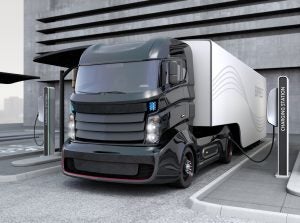California’s smart and economically savvy plan for electrifying trucks
 California is working on a bold new plan that will put more electric trucks on the streets, and take dangerous pollution out of the air. Under this plan, manufacturers of medium- and heavy-duty trucks will be required to sell more new electric and fuel-cell options in California, starting in 2024. The final details of this rule will be released over the next few months.
California is working on a bold new plan that will put more electric trucks on the streets, and take dangerous pollution out of the air. Under this plan, manufacturers of medium- and heavy-duty trucks will be required to sell more new electric and fuel-cell options in California, starting in 2024. The final details of this rule will be released over the next few months.
The rule stands to have huge benefits for the 12 million Californians who live in areas with high levels of air pollution. Despite making up just 7% of vehicles on the road, medium- and heavy-duty trucks release 35% of the state’s total NOx and 25% of diesel particulate matter, significantly impacting nearby communities’ health. In fact, vehicles and the fossil fuels that power them create more air pollution and greenhouse gas emissions than any other source across the state.
How the manufacturing standard works
A similar framework has already been highly successful for passenger vehicles — 8% of new cars purchased last year in California were plug-in electric or fuel cells, a number which is expected to grow. Now that this approach has been tested, it is primed to work for larger vehicles too. This long-term regulatory certainty will give a clear signal for more medium- and heavy-duty charging infrastructure to be built.
- If adopted, the existing proposal would require:
At least 50% of Class 4-8 vocational trucks (broad spectrum of trucks ranging from walk-in package delivery vans, to box-trucks for beverage delivery, to utility trucks) are electric. - At least 15% of the sales of other types of trucks (like cargo vans and regional haulers) are electric.
In an initial public review of the plan last December, the California Air Resources Board directed its staff to strengthen this initial plan by increasing the number of electric trucks that will be required. The board also directed the staff to focus more benefits toward disadvantaged communities.
California’s smart and economically savvy plan for electrifying trucks Share on XAt a workshop held last week, CARB rolled out some of the finer details of how it will upgrade its plan:
- Move up the deadline for pick-up trucks. Based on the numerous recent announcements, about electric pick-up truck availability, including the new Tesla Cybertruck, CARB staff is moving the start date for medium-duty pickup trucks (Class 2b-3 trucks) up from 2027 to 2024. This is great news for pick-up drivers who want a cleaner option for the environment.
- Increase percentage targets. CARB indicated its willingness to increase the percentages of new electric vehicles required to be sold across truck categories, but did not indicate by how much.
EDF recommends that CARB staff adjust the percentages to:
- Ensure that there are sufficient trucks available to achieve the fleet goals.
- Evaluate what it would take to achieve 100% electric for at least certain segments, as discussed by several board members.
- These percentages should be based both on feasibility and what would maximize air quality benefits for communities living in pollution hot spots.
Complimentary electric fleet goals
A complementary, but separate, rule will soon be underway for fleet purchasers. This demand-side rule will likely set targets for fleet adoption of electric trucks that are consistent with achieving 100% electric drayage (port) trucks by 2035 and 100% “final mile” delivery trucks, refuse trucks, and local buses by 2040.
These are great targets, because these trucks are causing the most air pollution in local communities. At the same time, some of the trucks identified as “first/last mile delivery, refuse trucks, and local buses,” may be ripe for 100% electrification before 2040. These programs can be coupled with financing programs to help offset the upfront costs of transitioning to an all-electric fleet.
It is important that CARB take into account these upcoming fleet goals as it finalizes the percentages in the manufacturer standard.
Why now
Growing urgency to improve air quality and reduce greenhouse gas emissions is one key reason the state is moving in this direction, but electric vehicle technology has also never been more affordable, and this is especially true for medium- and heavy-duty vehicles.
According to CARB’s models, many electric vehicles will soon be cheaper to own and operate than traditional gas-powered vehicles because they require less maintenance over time and electricity costs much less than fossil fuels. It’s another reason why we’re seeing more companies gravitate toward zero-emission fleets. There’s also the fact that consumers want greener, more eco-conscious choices.
Many companies who own big fleets — including Amazon, Anheuser Busch, and PepsiCo — have already started to invest in cleaner electric vehicles. This new proposal will help ensure that companies large and small have access to high-quality electric trucks in the years ahead.
Imagine a future where you know that your products are delivered with the lowest carbon footprint possible, and without harming communities along our freeways. While the opposite is true today, with the right considerations in place, that vision could become a reality.










